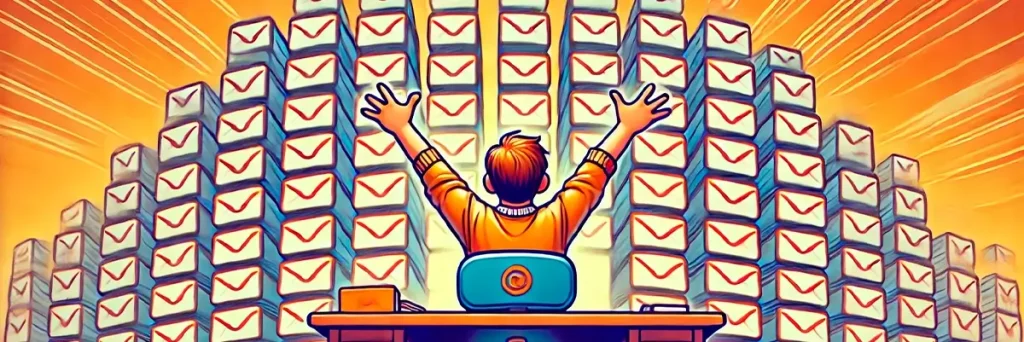In order to generate satisfactory results, email lists need to be built in the right way.
First and foremost, you need to think of an email database as a reservoir of data through which you can communicate with your leads.
There are those who prefer to buy email lists in order to obtain a register of leads in a more practical way. However, what few people know is that this action is very damaging to the sender’s reputation.
This is because buying bases is an action that is severely penalized by the recipients’ ISPs, which classify it as a spamming technique.
Purchased lists contain all kinds of risky emails, and may even contain spam carrying phishing scams.
There are also disposable addresses, no engagement, bounces and other types of invalid contacts that are harmful to email marketing results.
In other words, buying mailing lists is a shot in the foot.
But where do you start to build a base in the right way?

Table of contents
How to build your mailing lists online
This is the top of the funnel; the moment when the company launches its content on the Internet in search of people who might be interested.
Generally, the content (which can be an ebook, a webinar, a template, a trial of the service, among others) is rich and aims to make the public aware of a need they didn’t know they had.
Everything is done subtly and without mentioning the company name. Anyone interested in the content will sign up on a landing page to access it.
That’s where the trick comes in: the landing page will capture the prospect’s data so that they can access the material.
And is this data enough for you to create your email lists? The answer is no.
For the goal of generating leads to materialize, the real-time email checker API must be integrated with the data collection service.
Real-time verification prevents invalid emails from entering the lists, which ensures that the base collected from the forms reaches the recipients’ inbox, and not the spam box.
In other words, it’s no use just collecting the emails of people who have signed up to your landing page. You need to validate them using the verification API. Only after this process does lead generation take place.
Double opt-in
Anyone who works with email marketing knows the importance of obtaining permission from recipients.
That’s where the form comes from when building email lists, because in it, the person authorizes receiving your communications.
This procedure, carried out by everyone who doesn’t work with spam, is called single opt-in.
Double opt-in works as an additional layer of confirmation that the lead is interested in receiving your communications.
It is done as follows: after the lead confirms the form with the single opt-in, a confirmation email is sent (double opt-in).
Some people think that double opt-in is detrimental to the registration process. See why below.
Are there any disadvantages to double opt-in when building email lists?
Yes, there is. As double opt-in requires two stages to complete the registration process, some leads may not confirm the final stage.
The email may go unnoticed, the lead may forget to confirm, give up, among other reasons that could decrease the size of your email lists if you had opted for the single opt-in (the one that is inserted into the form).
On the other hand, lists built on the basis of double confirmation are much more solid, since the lead has proven their interest.
In this way, the reputation of the senders achieves a high standard of quality.
Offline methods for building mailing lists
Those who work outside of digital also have the chance to build mailing lists. And even if your company is only present online, there are always ways to create external events that capture lead data.
Totem
It can be used in an exhibition or at events, attracting people who are curious to learn more about the product/service.
Contrary to what many people think, a totem doesn’t require a large investment. It can be built using a simple acrylic structure with a tablet that supports the form. The important thing is not to use paper.
And what’s even more important is to use the real-time email checker API to prevent invalid emails from entering the lists.
Trial, freemium, experiences
Offering a chance to try the product or service is one of the most attractive ways of qualifying leads, who in turn will give up their details to access the experience.
Examples of experiences like this are:
- Test-drives.
- 3D experiences.
- Trial systems.
- Freemium, among others.
It’s worth noting that testing can also be used as an online strategy for attracting leads, in trial and freemium formats.
Loyalty clubs
Loyalty cards exist precisely to fulfill this purpose: to build loyalty. And in order for customers to have access to the club’s advantages, the currency of exchange is their data.
As with tastings, the Loyalty Club is also a method of attracting leads online.

Conclusion
Anyone who prioritizes quality in digital marketing and extends this premise to email marketing strategies should pay attention to the following details when building their email lists:
- Never buy bases or exchange leads. Building a personalized list guarantees the security your company needs to talk to leads that are yours alone. In other words: a mailing list is always individual and non-transferable!
- Validate your lists. Otherwise, all your efforts will have been in vain. Bases without frequent verification are susceptible to emails becoming invalid overnight. And it’s always good to remember that lists containing 3% bounces are blocked.
- Use double opt-in wisely. If you want to build a mailing list for a quick, one-off mailing event, give priority to the single opt-in. However, if your intention is to form a base with which you will communicate frequently, use double opt-in.
FAQ
Why isn’t a registration form enough to create email lists that generate leads?
Emails collected from forms generate “raw” lists, i.e. you don’t know how many contacts are spam, disposable, unengaging and other types of harmful addresses. Only email validation will deliver a clean, bounce-free list, which means that all existing contacts will be active and therefore promising leads.



